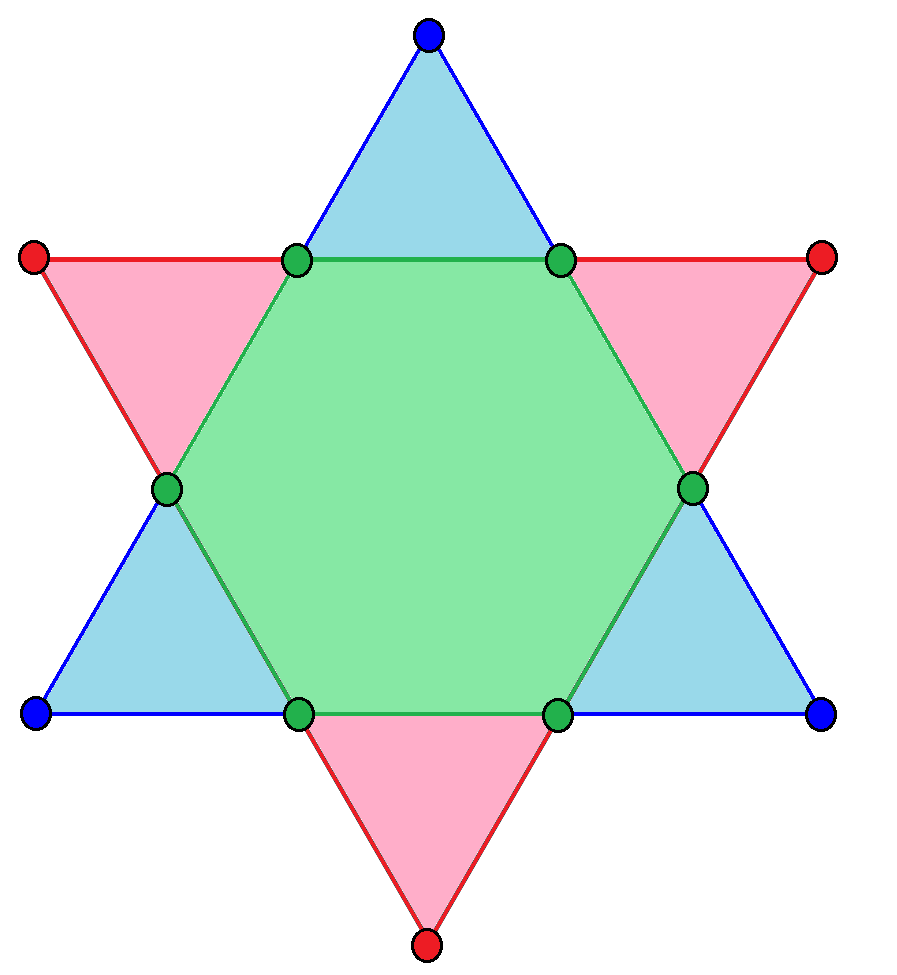|
Star Polygon
In geometry, a star polygon is a type of non-convex polygon. Regular star polygons have been studied in depth; while star polygons in general appear not to have been formally defined, Decagram (geometry)#Related figures, certain notable ones can arise through truncation operations on regular simple or star polygons. Branko Grünbaum identified two primary usages of this terminology by Johannes Kepler, one corresponding to the regular star polygons with List of self-intersecting polygons, intersecting edges that do not generate new vertices, and the other one to the isotoxal Concave polygon, concave simple polygons.Grünbaum & Shephard (1987). Tilings and Patterns. Section 2.5 Polygram (geometry), Polygrams include polygons like the pentagram, but also compound figures like the hexagram. One definition of a ''star polygon'', used in turtle graphics, is a polygon having ''q'' ≥ 2 Turn (geometry), turns (''q'' is called the turning number or Density (polygon), density), like in ... [...More Info...] [...Related Items...] OR: [Wikipedia] [Google] [Baidu] |
Concave Polygon
A simple polygon that is not convex is called concave, non-convex or reentrant. A concave polygon will always have at least one reflex interior angle—that is, an angle with a measure that is between 180° degrees and 360° degrees exclusive. Polygon Some lines containing interior points of a concave polygon intersect its boundary at more than two points. Some diagonals of a concave polygon lie partly or wholly outside the polygon. Some sidelines of a concave polygon fail to divide the plane into two half-planes one of which entirely contains the polygon. None of these three statements holds for a convex polygon. As with any simple polygon, the sum of the internal angles of a concave polygon is (''n'' − 2) radians, equivalently 180°(''n'' − 2) degrees, where ''n'' is the number of sides. It is always possible to partition a concave polygon into a set of convex polygons. A polynomial-time algorithm for finding a decomposition into as few convex pol ... [...More Info...] [...Related Items...] OR: [Wikipedia] [Google] [Baidu] |
Greek Language
Greek (, ; , ) is an Indo-European languages, Indo-European language, constituting an independent Hellenic languages, Hellenic branch within the Indo-European language family. It is native to Greece, Cyprus, Italy (in Calabria and Salento), southern Albania, and other regions of the Balkans, Caucasus, the Black Sea coast, Asia Minor, and the Eastern Mediterranean. It has the list of languages by first written accounts, longest documented history of any Indo-European language, spanning at least 3,400 years of written records. Its writing system is the Greek alphabet, which has been used for approximately 2,800 years; previously, Greek was recorded in writing systems such as Linear B and the Cypriot syllabary. The Greek language holds a very important place in the history of the Western world. Beginning with the epics of Homer, ancient Greek literature includes many works of lasting importance in the European canon. Greek is also the language in which many of the foundational texts ... [...More Info...] [...Related Items...] OR: [Wikipedia] [Google] [Baidu] |
Penta-
Numeral or number prefixes are prefixes derived from numerals or occasionally other numbers. In English and many other languages, they are used to coin numerous series of words. For example: *triangle, quadrilateral, pentagon, hexagon, octagon (shape with 3 sides, 4 sides, 5 sides, 6 sides, 8 sides) * simplex, duplex (communication in only 1 direction at a time, in 2 directions simultaneously) * unicycle, bicycle, tricycle (vehicle with 1 wheel, 2 wheels, 3 wheels) * dyad, triad, tetrad (2 parts, 3 parts, 4 parts) * twins, triplets, quadruplets (multiple birth of 2 children, 3 children, 4 children) * biped, quadruped, hexapod (animal with 2 feet, 4 feet, 6 feet) * September, October, November, December ( 7th month, 8th month, 9th month, 10th month) * binary, ternary, octal, decimal, hexadecimal (numbers expressed in base 2, base 3, base 8, base& ... [...More Info...] [...Related Items...] OR: [Wikipedia] [Google] [Baidu] |
Spirolateral
In Euclidean geometry, a spirolateral is a polygon created by a sequence of fixed vertex internal angles and sequential edge lengths 1,2,3,...,''n'' which repeat until the figure closes. The number of repeats needed is called its cycles. Gardner, M. ''Worm Paths'' Ch. 17 ''Knotted Doughnuts and Other Mathematical Entertainments'' New York: W. H. Freeman, pp. 205-221, 1986/ref> A ''simple spirolateral'' has only positive angles. A simple spiral approximates of a portion of an archimedean spiral. A ''general spirolateral'' allows positive and negative angles. A ''spirolateral'' which completes in one turn is a simple polygon, while requiring more than 1 turn is a star polygon and must be self-crossing. A simple spirolateral can be an equangular simple polygon with ''p'' vertices, or an equiangular star polygon with ''p'' vertices and ''q'' turns. Spirolaterals were invented and named by Frank C. Odds as a teenager in 1962, as ''square spirolaterals'' with 90° angles, drawn on ... [...More Info...] [...Related Items...] OR: [Wikipedia] [Google] [Baidu] |
Density (polygon)
In geometry, the density of a star polyhedron is a generalization of the concept of winding number from two dimensions to higher dimensions, representing the number of windings of the polyhedron around the center of symmetry of the polyhedron. It can be determined by passing a ray from the center to infinity, passing only through the facets of the polytope and not through any lower dimensional features, and counting how many facets it passes through. For polyhedra for which this count does not depend on the choice of the ray, and for which the central point is not itself on any facet, the density is given by this count of crossed facets. The same calculation can be performed for any convex polyhedron, even one without symmetries, by choosing any point interior to the polyhedron as its center. For these polyhedra, the density will be 1. More generally, for any non-self-intersecting (acoptic) polyhedron, the density can be computed as 1 by a similar calculation that choos ... [...More Info...] [...Related Items...] OR: [Wikipedia] [Google] [Baidu] |
Turning Number
In mathematics, the winding number or winding index of a closed curve in the plane around a given point is an integer representing the total number of times that the curve travels counterclockwise around the point, i.e., the curve's number of turns. For certain open plane curves, the number of turns may be a non-integer. The winding number depends on the orientation of the curve, and it is negative if the curve travels around the point clockwise. Winding numbers are fundamental objects of study in algebraic topology, and they play an important role in vector calculus, complex analysis, geometric topology, differential geometry, and physics (such as in string theory). Intuitive description Suppose we are given a closed, oriented curve in the ''xy'' plane. We can imagine the curve as the path of motion of some object, with the orientation indicating the direction in which the object moves. Then the winding number of the curve is equal to the total number of counterclockwi ... [...More Info...] [...Related Items...] OR: [Wikipedia] [Google] [Baidu] |
Turn (geometry)
The turn (symbol tr or pla) is a unit of plane angle measurement that is the measure of a complete angle—the angle subtended by a complete circle at its center. One turn is equal to radians, 360 degrees or 400 gradians. As an angular unit, one turn also corresponds to one cycle (symbol cyc or c) or to one revolution (symbol rev or r). Common related units of frequency are '' cycles per second'' (cps) and '' revolutions per minute'' (rpm). The angular unit of the turn is useful in connection with, among other things, electromagnetic coils (e.g., transformers), rotating objects, and the winding number of curves. Divisions of a turn include the half-turn and quarter-turn, spanning a straight angle and a right angle, respectively; metric prefixes can also be used as in, e.g., centiturns (ctr), milliturns (mtr), etc. In the ISQ, an arbitrary "number of turns" (also known as "number of revolutions" or "number of cycles") is formalized as a dimensionless ... [...More Info...] [...Related Items...] OR: [Wikipedia] [Google] [Baidu] |
Turtle Graphics
In computer graphics, turtle graphics are vector graphics using a relative cursor (the "turtle") upon a Cartesian plane (x and y axis). Turtle graphics is a key feature of the Logo programming language. It is also a simple and didactic way of dealing with moving frames. Overview The turtle has three attributes: a location, an orientation (or direction), and a pen. The pen, too, has attributes: color, width, and on/off state (also called ''down'' and ''up''). The turtle moves with commands that are relative to its own position, such as "move forward 10 spaces" and "turn left 90 degrees". The pen carried by the turtle can also be controlled, by enabling it, setting its color, or setting its width. A student could understand (and predict and reason about) the turtle's motion by imagining what they would do if they were the turtle. Seymour Papert called this "body syntonic" reasoning. A full turtle graphics system requires control flow, procedures, and recursion: many turtl ... [...More Info...] [...Related Items...] OR: [Wikipedia] [Google] [Baidu] |
Hexagram
, can be seen as a compound polygon, compound composed of an upwards (blue here) and downwards (pink) facing equilateral triangle, with their intersection as a regular hexagon (in green). A hexagram (Greek language, Greek) or sexagram (Latin language, Latin) is a six-pointed geometric star figure with the Schläfli symbol , 2, or . The term is used to refer to a compound figure of two equilateral triangles. The intersection is a regular hexagon. The hexagram is part of an infinite series of shapes which are compounds of two n-dimensional simplex, simplices. In three dimensions, Compound of two tetrahedra, the analogous compound is the stellated octahedron, and in four dimensions the compound of two 5-cells is obtained. It has been historically used in various religious and cultural contexts and as decorative motifs. The symbol was used as a decorative motif in medieval Christian churches and Jewish synagogues. In the medieval period, a Muslim mystical symbol known as the Seal ... [...More Info...] [...Related Items...] OR: [Wikipedia] [Google] [Baidu] |




